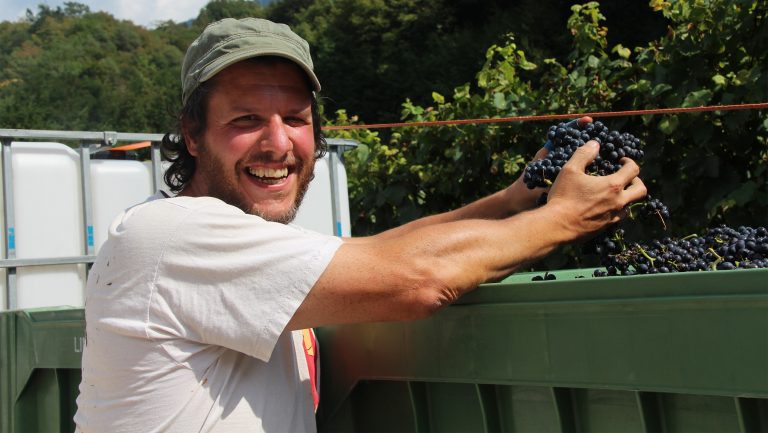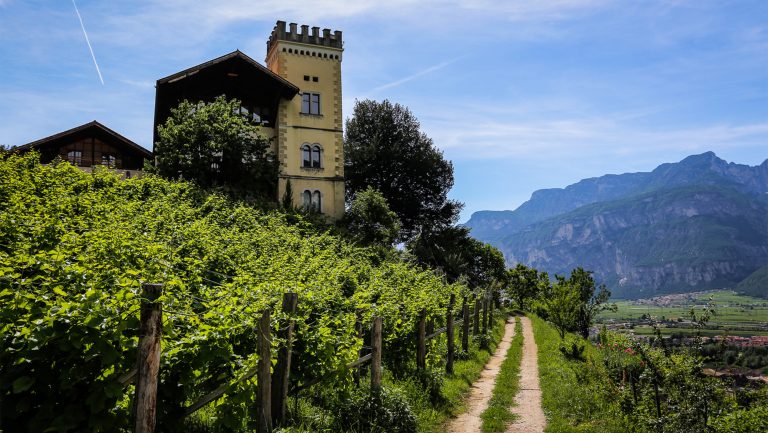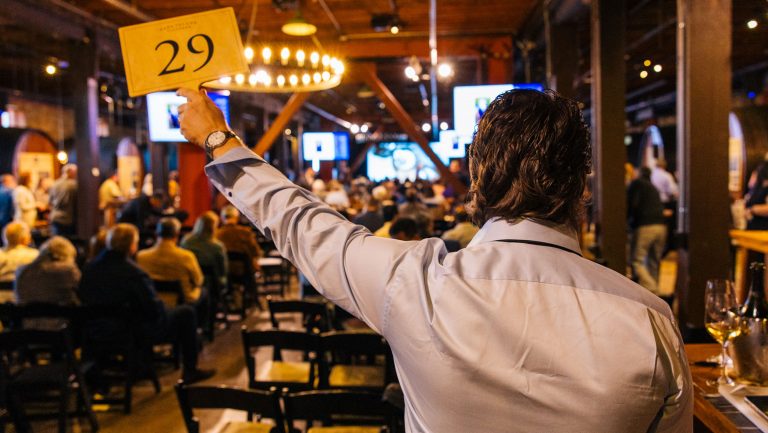Alto Adige’s staggering, verdant terrain and ingrained traditions would seem to make it the perfect hub for regenerative viticulture. Yet organic and, especially, biodynamic winegrowing has been slow to take hold in this mountainous region. In recent years, a pioneering group of small growers, visionary estates, and grassroots organizations—which include several co-ops—is working to change course for the region. These innovators are layering in a new identity for Alto Adige, one that reflects its environment and traditions—and may foretell a paradigm shift.
The Beginnings of Transformation
“A big, green garden” is how biodynamic winegrower Patrick Uccelli of Ansitz Dornach, a mixed-crop biodynamic farm in the rugged, castle-crowned hills above Salurn, describes Alto Adige. “We can grow more or less everything,” he says. But over the last half-century, “everything” has been narrowed to two things: apples and wine grapes. These monocultures are now integral to the region’s farming traditions.

Don’t miss the latest drinks industry news and insights. Sign up for our award-winning newsletters and get insider intel, resources, and trends delivered to your inbox every week.
Alto Adige’s 5,000 winegrowers, many of whom are part-time hobbyists, work an average of just over a hectare each. Most feed the dozen cooperatives that are responsible for approximately 70 percent of the region’s production. Independent wineries and private estates, dotted across a range of valleys and clustered around the regional capital of Bolzano, account for roughly 30 percent of the Alto Adige’s other wines. Collectively, they turn out some 40 million bottles a year, most destined for consumption at home, in Germany, and in the U.S.
It’s a system that works well—almost too well, at least when it comes to opening the door to change. “You can live very well from farming here, which is very positive,” notes Dr. Georg Meissner. “But if you have to struggle to make things different, you’re forced to be much more creative.” A resident of Alto Adige, Meissner is a renowned instructor of biodynamic viticulture at Germany’s Geisenheim University and the Swiss Goetheanum school and was, until last year, the enologist for the region’s best-known biodynamic estate, Alois Lageder.
There are no official numbers for biodynamic viticulture in Alto Adige (with or without certification), but best estimates put the total near 300 hectares, or roughly 5 percent of the region’s total. Three estates—Alois Lageder, Ansitz Dornach, and Tröpfltalhof—are Demeter certified, and one, Manincor, belongs to the high-profile respekt-BIODYN group. Alongside them are a handful of small, uncertified biodynamic growers like Pranzegg, In der Eben, and Haderburg.
Despite these slim numbers, “there is more to the biodynamic wine scene than people outside the region realize,” Meissner says. “This includes small growers, bigger structures, and a lively working group of biodynamic farmers and winegrowers.” Moreover, he sees Alto Adige as “a very interesting place of tradition and transformation, and of what’s coming towards us from the future.”
Natural Advantages
Alto Adige’s physical and cultural landscape predisposes it to a key element of biodynamics: the integration of animals into winegrowing. “I talk with some older growers and they tell me how they used to walk their ox through the vineyards,” notes Jo Pfisterer, Alois Lageder’s current enologist. The interplay of livestock and other crops was part and parcel of Rudolf Steiner’s vision for holistic agriculture. The region’s high Alpine pastures and tradition of transhumance plug into this in a way few other regions can.
Moreover, the cornerstone of biodynamics is the concept of the farm as a closed system open to human guidance and cosmic influence. “This type of farming disappeared from this area 50 years ago,” says Uccelli. “Now it looks like something special. But it’s not. It was normal.” And as this approach comes back, it can be argued that Alto Adige is, in an important way, becoming more itself.

Beyond this—as in other dry, sunny regions, such as Alsace or the Pfalz—lower rainfall, humidity, and disease pressure make biodynamic farming easier in Alto Adige. Romana Echensperger MW, author of a recent book that examines biodynamic viticulture in several European regions, including Alto Adige, cites an increasing awareness among growers that the region’s twin monocultures are not viable long-term. As climate change forces them to look for new ways to retain the signature Alpine freshness of the region’s hallmark Schiava, Pinot Grigio, and Pinot Bianco wines, “biodynamic methods offer a possibility to temper these challenges,” she believes.
Biodynamic practices—from intensive composting to work with teas and preparations tailored to the individual needs of a particular plot of land—build moisture-retaining soils, resilient vines, and ecosystem stability, all of which are already critical needs in Alto Adige, where some of the highest growing-season temperatures in all of Italy are routinely recorded.
The Journey to Biodynamics
Alto Adige is a sprawling playground of natural parks, Alpine peaks, and staggering valleys. But only a tenth of it is cultivable. Scarcity has pushed land prices skyward, topping a million euros per hectare. These daunting land costs have curbed growers’ appetites for taking chances with new farming methods or investing in biodiversity in ways that could cut into productive vineyard area. Part-time growers, who in many cases have inherited tiny parcels, may lack the time and manpower that biodynamic farming requires. There is also the bottleneck of an older generation that has been especially slow to hand over the reins.
Lack of wider market awareness is another issue. Martin Gojer and his partner Marion Untersulzner grow and make the wildly popular biodynamic Pranzegg wines. “It’s true that in certain circles the visibility of the new [biodynamically farmed] style of South Tyrol wine is increasing,” says Gojer, “but there’s also no doubt the quantity, the share of these wines is still vanishingly small.”
What will it take for biodynamics to take root more firmly in Alto Adige? “Subsidies, knowledge transfer, finding ways to balance risk, an increase in both scientific research and in the number of positive role models all would help,” says Echensperger. But it may also just be a matter of a little more time and a lot more attention from the outside world to what’s already happening.
For a wine region that has struggled to gain a more individualized identity, the ability of biodynamically grown grapes to translate terroir may be a key motivator for growers.
In 1979, Ranier Loacker became the first in the region to embrace biodynamics on his seven-hectare estate in Bolzano. Soon after, others noticed—notably a young Alois Lageder, who had recently taken over his family’s estate and was remaking and expanding the winery. Lageder wanted to build on what he knew from his upbringing about working in accord with natural forces. But he hesitated, fearing the unknowns of biodynamics at a time when consultants, like-minded colleagues, and convincing examples of biodynamic wines were scarce.
But two decades later, a shift had begun. Cantina Kaltern, a large co-op on the shores of Lake Kaltern, was nurturing a small group of biodynamic grower-members who were beginning to witness first-hand how these farming practices yielded superior crops. Hannes Rohregger, viticultural manager at Kaltern today, explains that the co-op’s cellarmaster at the time supported these biodynamic members with regular exchanges of ideas and practices. For a while, the Cantina even bottled and sold a biodynamic wine, though “the time wasn’t yet right and it struggled to find a market,” he adds.
In 2004, Alois Lageder was ready to adopt biodynamics across his 55 hectares in and around the village of Magré, not far from Kaltern. The primary challenge, says Helena Lageder, Alois Lageder’s daughter, was convincing everyone involved in their extensive operations (the estate turns out 1.2 million bottles a year)of the benefits of biodynamics.
Eight years later, the Lageders brought Meissner on board and together developed a process, continually refined in response to real-world practice, that gives grower-partners several years to adopt biodynamics under the mentorship of a dedicated team. Helena Lageder says her family has seen a steady increase in interest among growers “who are already working organically or biodynamically or who want to convert and don’t want to entrust their grapes to a partner who mixes them with conventional grapes.”

Today, nearly a third of the Lageder’s 80 grower-partners farm biodynamically, a feat Echensperger acknowledges as “amazing—but also involving a lot of effort and business risk.” That effort and risk are undertaken by the grower-partners, too—but from their perspective, having a steady market for grapes even in a bad year for disease or pest pressures gives them the support to work as they wish.
A Strong Network for a Common Goal
The Bolzano-based Working Group for Bio-Dynamic Management connects and nourishes both established and up-and-coming biodynamic growers, building a more robust framework for biodynamics to flourish. The group counts 200 farmers—not just winegrowers—most in Alto Adige, but also in neighboring Trentino.
“We get 20 to 30 new farmers coming to us every year,” explains Andreas Dichristin, who sits on the group’s board and is himself a small-scale biodynamic grower at Tröpfltalhof. “Not all go on to convert, but the development is definitely positive.” Currently, the group includes 36 growers in Alto Adige alone, accounting for about half of the region’s vineyard hectares under biodynamic cultivation.
Its members range from Dieter Oberhofer, who supplies grapes to Alois Lageder, to supporters like Micheal Count Goëss-Enzenberg, who leads the 400-year-old, 50-hectare Manincor estate in Kaltern. He sees this ground-up cooperation as vital: “We make some of our preparations with the working group, we follow their courses, we help each other out. That’s very important for the development of biodynamics in Alto Adige.” He also points to three co-ops that are part of this development.
Cantina Kaltern’s Rohregger, for instance, says the co-op continues to nurture its tiny band of biodynamic grower members both through grape price premiums and regular meetings. And the grapes grown by these grower-members (and their organic counterparts) are again being bottled separately under the Solos label.
Hayo Loacker, Rainer’s son and head of the estate since 1998, explains that his draw to biodynamics is its conduciveness to transmitting terroir. “By keeping soil vitality at a constant high level, the vines are enabled to interact with their terroir and transmit it directly to their fruits,” he says. “So the wines made from biodynamically grown grapes tell the true story of their origin.” For a wine region that has struggled to gain a more individualized identity, this may be a key motivator for growers, as well.
“The impulses contained in biodynamic practice allowed us to organize our farm in such a way as to establish a solid relationship between what we cultivate and the development of our spirit,” says Ansitz Dornach’s Uccelli. “To cultivate the earth, the soil, is to cultivate the spirit. In this sense, Dornach is a place of cultivation, but also of culture.”
In many ways, Uccelli sits at the nexus of Alto Adige’s worlds, collaborating with the working group, making his own line of superb, highly individualistic wines, and continuing a family tradition of selling half his grapes to the Lageders. He may well represent the new paradigm for biodynamics in Alto Adige—and beyond.

Dispatch
Sign up for our award-winning newsletter
Don’t miss the latest drinks industry news and insights—delivered to your inbox every week.
Valerie Kathawala is a New York-based journalist specializing in the wines of Austria, Germany, South Tyrol, and Switzerland. She is also the co-founder and co-editor of TRINK Magazine. She holds a WSET 3 certification.







